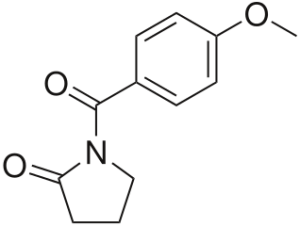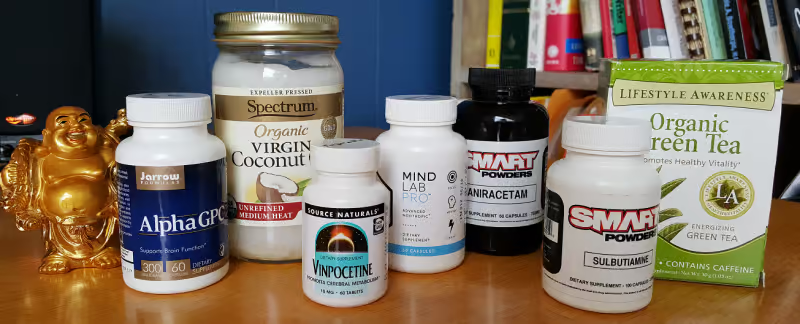Table of Contents
Aniracetam (1-p-anisoyl-2-pyrrolidinone) is a fat-soluble ampakine nootropic in the racetam-class of compounds. Aniracetam is up to 10-times more potent than the original racetam, Piracetam.
Aniracetam was patented by Swiss-based pharmaceutical company F. Hoffmann-La Roche AG in the 1978. It is similar in structure to Piracetam. Aniracetam, like all racetam nootropics, has a pyrrolidone nucleus at its core.
Aniracetam is sold as a prescription drug (Ampamet, Draganon, Memodrin, Referan, Sarpul) in Europe. And as a supplement in the United States.
A favorite racetam among the nootropics community. Neurohackers use Aniracetam to boost memory and learning. And to relieve anxiety, depression, stress, and improve sociability.[i]
Aniracetam helps:
- Brain Optimization: Aniracetam significantly improves brain function after traumatic brain injury including stroke (ischemia).[ii] And enhances your brain’s ability to repair damaged cell membranes.
- Neurotransmitters: Aniracetam reduces the desensitization of glutamate (AMPA) receptors in your brain. Which boosts neural signaling by increasing the effectiveness of glutamate. Resulting in better focus and concentration.[iii]
- Brain Energy: Aniracetam improves memory and recall. It releases 200 – 300% more acetylcholine in the brain. Which can increase focus, and clarity of thought.[iv]
Overview

Aniracetam is in the racetam-family of nootropic compounds. It is a fat-soluble ampakine nootropic. AMPA (α-amino-3-hydroxy-5-methyl-4-isoxazolepropionic) refers to one of three glutamate receptors in your brain.[v]
The racetam-class of nootropics have a pyrrolidone nucleus at their core. And Aniracetam is a Cholinergic compound, meaning it affects acetylcholine levels in the brain.
Aniracetam is sold as a prescription drug in Europe and some of Asia under the names Ampamet, Draganon, Memodrin, Referan, and Sarpul. It is sold as an over-the-counter, unrestricted compound in the United States. But not as a dietary supplement.
One of the original synthetic nootropic compounds, it is known as a cognitive enhancer. And is known for its anxiolytic, or anti-anxiety effects.
Aniracetam is considered to be up to 10-times more potent than Piracetam. As an ampakine nootropic, it helps increase attention span, alertness and boosts memory.
Ampakines tend to have a stimulant effect. But do not produce the same stimulant side effects as Ritalin or coffee from prolonged use.
Aniracetam vs. Piracetam: What’s the Difference?
Swiss-based pharmaceutical company F. Hoffmann-La Roche AG developed Aniracetam in the late 1970’s as a derivative of Piracetam.
Aniracetam is fat-soluble while Piracetam is water-soluble. Fat-soluble molecules cross the blood-brain barrier more easily than water-soluble molecules.
Aniracetam works faster in the brain after taking it than Piracetam because of its superior bioavailability to the brain. But its effects don’t last as long as Piracetam.
 The potency of Aniracetam seems almost counter-intuitive. Because most of an Aniracetam dose is lost in the liver during digestion. Only 0.2% or the original dose is available to the brain.[vi] Piracetam is nearly 100% bioavailable.[vii]
The potency of Aniracetam seems almost counter-intuitive. Because most of an Aniracetam dose is lost in the liver during digestion. Only 0.2% or the original dose is available to the brain.[vi] Piracetam is nearly 100% bioavailable.[vii]
Both Aniracetam and Piracetam are cognitive enhancers. And both have neuroprotective qualities. Both racetams are able to improve learning and memory. And both are able to repair brain damage.
Aniracetam has additional benefits not shared with Piracetam. Aniracetam can reduce anxiety, depression and fear. And increase sociability.[viii] This may indicate its effects on dopamine and serotonin receptors in the brain.
How does Aniracetam Work in the Brain?
Aniracetam boosts brain health and function in several ways. But two in particular stand out.
- Aniracetam modulates AMPA receptors in the brain. The main metabolite of Aniracetam (70-80%) is N-anisoyl-GABA and is responsible for many of its effects.
2-Pyrrolidinone and p-anisilic acid are additional metabolites of the drug (20-30%), both of which are also active.[ix]
The main function of these metabolites is on the glutamate system in the brain. It reduces the desensitization of glutamate receptors. This causes the neurotransmitter glutamate to become more available in the brain.
More glutamate means better cognition and memory. And neural protection and repair due to brain injury.
- Aniracetam also seems to affect dopamine and serotonin receptors in the brain. Leading to improved mood and sociability.
One study published in the European Journal of Pharmacology demonstrated the anti-anxiety effects of Aniracetam. Researchers tracked the brain pathways in mice showing Aniracetam’s mechanism of action.[x] Illustrating the effect on dopamine and serotonin.
How things go bad
Glutamate is an excitatory relative of GABA. While GABA has a calming effect, glutamate stimulates. Glutamate is the most common neurotransmitter in the central nervous system.
But glutamate is actually toxic to neurons. And too much of it in your brain can kill brain cells. Lou Gehrig’s Disease for example, is caused by excess glutamate.
But glutamate is a pivotal neurotransmitter in the brain. It links the brain circuits involved in memory, learning and perception.
↑ Too much glutamate can kill neurons
↓ Too little glutamate can cause problems with memory, learning and perception
↓ Acetylcholine levels decline
All of these changes can happen at any age. And are a product of the food we eat, what we drink, lifestyle habits, the air we breathe and more.
So Aniracetam can help for age-related cognitive decline, as well as a student looking to do better in school. By boosting acetylcholine and controlling glutamate in the brain.
Aniracetam benefits
Aniracetam modulates AMPA receptors which are involved in how glutamate is used in your brain. More of the neurotransmitter glutamate is available. Which means better neural signaling across synapses. Your brain is working optimally despite stress, fatigue and anxiety.
There is anecdotal evidence that Aniracetam boosts communication between left and right brain hemispheres. You become more creative. And are prone to making innovative and resourceful decisions.
Aniracetam combined with choline boosts the production of the crucial neurotransmitter acetylcholine. Improving memory, recall and focus.
Aniracetam is fat-soluble and quickly enters your brain after you take it. Once in your brain, it boosts signal transmission, and protects neurons.
Aniracetam boosts acetylcholine so you should add a good choline source. Try Alpha GPC or CDP-Choline with Aniracetam. And give your brain the choline it needs.
How does Aniracetam feel?
Nootropics users report:
- Aniracetam as a study aid. On its own, Aniracetam seems to increase attention span for many neurohackers. And when combined with caffeine, many report being able to work effortlessly for hours on end.
 Increased auditory perception. If you love music, Aniracetam can take you deeper into your listening experience. Minute details like background guitars, and other auditory effects come alive. Every instrument becomes part of the sound stage.
Increased auditory perception. If you love music, Aniracetam can take you deeper into your listening experience. Minute details like background guitars, and other auditory effects come alive. Every instrument becomes part of the sound stage.- Increased visual acuity. The visual effects of Aniracetam feel like your brain is processing a broader spectrum of what’s in your visual range. Nature and your surroundings look more vibrant and beautiful.
- Sociability. Many users report being able to articulate thoughts, and improved speaking ability. Language and your vocabulary seem to flow effortlessly. Thoughts and ideas come with less effort.
You should be able to experience the effects of Aniracetam soon after you take it. It’s fat-soluble so it’s digested and enters your cells quickly. A 750 mg dose of Aniracetam should last for several hours. And unlike other stimulants, there is no “crash” once Aniracetam leaves your system.
Aniracetam Clinical Research
Researchers worked with 276 patients with cognitive disorders. They were given Aniracetam and tested at 3, 6 and 12 months.
Improved emotional states and better motor functionality was observed within 3 months. A boost in cognitive performance was observed within 6 months.
Findings concluded Aniracetam “is a promising option for patients with cognitive deficit” disorders. Improvements held throughout the 12-month study. And there was a favorable effect on emotional stability in patients with dementia.[xi]
Aniracetam as an Antidepressant
A study published in Psychopharmacology in 2001 showed Aniracetam helped stimulate the release of dopamine. The study reported Aniracetam as effective against depression caused by age-related brain dysfunction.[xii]
Aniracetam Improves Learning & Memory
Researchers put rats and mice through six scenarios. From drug-induced memory loss to electric shock avoidance, while administering Aniracetam. The results of all tests conclusively showed Aniracetam improving cognitive function. It didn’t matter what they put these animals through. Learning and memory improved with the use of Aniracetam.[xiii]
Aniracetam Repairs Fetal Alcohol Syndrome
We’re exposed to toxins everywhere we go. And in everything we do during our day. This toxin exposure wreaks havoc in our body, including our brain.
In this study, scientists showed one way to repair damage to synaptic transmission in the brain. They exposed pregnant Sprague-Dawley rats to ethanol and a saccharin-like sweetener. Pups born to these female rats would normally be extremely cognitively  impaired. Just like babies born to alcoholic mothers.
impaired. Just like babies born to alcoholic mothers.
In this study, the pups born with fetal alcohol syndrome were treated with Aniracetam 18 and 27 days after birth. Aniracetam completely restored synaptic transmissions in their brains. And reversed any cognitive deficits associated with fetal alcohol syndrome.[xiv]
Aniracetam Dosage
Recommended Aniracetam dosage is 1,500 mg per day. Taken in two 750 mg doses. One Aniracetam dose in the morning, and one in the early afternoon.
A 750 mg dose of Aniracetam taken in the morning will last until noon. And a noon 750 mg dose of Aniracetam should last until about mid-afternoon.
Aniracetam is sold in tablet, capsule and powder form. Tablets and capsules are usually 750 mg each.
Since Aniracetam is a fat-soluble nootropic, you should take it with a meal containing healthy fats. Or with a tablespoon of unrefined coconut oil, or extra virgin olive oil. My preferred healthy fat is a tablespoon of the new organic, non-GMO Performance Lab® MCT Oil.
Aniracetam Side Effects
Aniracetam is non-toxic. So is considered well-tolerated and safe.
Side effects are rare but can include anxiety, fatigue, headaches, nervousness and nausea. Side effects are often a result of unusually high doses of the nootropic.
Headaches from using Aniracetam typically happen when you forget to combine it with a good choline supplement. Headaches are often a symptom of a choline deficit in your brain.
Where to Buy Aniracetam
Aniracetam is sold in tablet, capsule and powder form. Tablets and capsules are usually 750 mg each.
You can buy Aniracetam from Smart Nutrition – Aniracetam in capsules. Or from Science.bio – Aniracetam for tubs of powder.
In Europe and some other countries around the world, Aniracetam is a prescription drug. And sold under the brand names Ampamet, Draganon, Memodrin, Referan, and Sarpul.
Nootropics Expert Recommendation
Aniracetam 1,500 mg per day
 I recommend using Aniracetam as a nootropic supplement.
I recommend using Aniracetam as a nootropic supplement.
Your body does not make Aniracetam on its own. So to get its benefits you must take it as a supplement.
Aniracetam is especially helpful for those suffering from depression. Studies show it helps stop and reverse the symptoms associated with depression. This nootropic helps boost the activity of dopamine and serotonin in your brain.
Personally, I’ve found Aniracetam to be more effective (and safer) than any prescription anti-depressant I’ve ever tried.
Aniracetam is also particularly useful to students and executives who want to boost cognition, learning and memory. My experience using Aniracetam shows it helps boost study scores, workflow, learning and memory.
Aniracetam also helps improve verbal fluidity and sociability. Words seem to come easily, and vocabulary you didn’t know you had access to come into play.
Music sounds richer and fuller, and your listening experience enters a new level of music appreciation.
You should use Aniracetam with a good choline supplement like Alpha GPC or CDP-Choline. It helps boost neural acetylcholine, so demands the presence of more choline in your brain.
You can safely boost daily intake of Aniracetam to 3,000 mg. if needed.
You can buy Aniracetam from Smart Nutrition – Aniracetam in capsules. Or from Science.bio – Aniracetam for tubs of powder.
And don’t forget that Aniracetam is a fat-soluble nootropic. So must be taken with a healthy fat for best results. My preferred healthy fat is a tablespoon of the new organic, non-GMO Performance Lab® MCT Oil.









Join The Discussion - 467 comments
Christopher Guarascio
October 25, 2020
Hi David,
In regard to a good fat source, how about and curious on your thoughts on MCT oil?
David Tomen
October 26, 2020
Christopher, MCT Oil is likely the best choice of a healthy fat because you’re getting a ‘twofer’. You’re getting the fat while you’re getting the ketones. I like that combo of benefits.
Gi
October 12, 2020
Dear David, I would like to know can you recomend any nootropics for autism curing. Thanks in advance.
David Tomen
October 13, 2020
Gi, I’ve done several personal consultations with parents of autistic children who asked the same question. And my research turned up several supplements with clinical studies showing the possibility of taming inflammation in the autistic brain.
Those nootropics included things like Artichoke Extract, NAC, BCAAs, CoQ10, ALCAR, etc. If you want more detail than that including links to the clinical studies I suggest setting up a consultation with me.
Gi
October 14, 2020
Thank you, but we have tried these supplements without any succes. Have you ever read about Pyritinol? I would like to read about it, but I can find enough information, unfortunately
David Tomen
October 14, 2020
Gi, Pyritinol is a semi-synthetic water-soluble analog of vitamin B6 (Pyridoxine) that was developed by Merck in 1961. I have not done the research and am not sure if it would help you.
Carl
September 15, 2020
Hi David,
Do you suggest to take Anieracetam in the morning or at night?
Thanks
David Tomen
September 15, 2020
Carl, I recommend using it morning and noon. No need to use it a night. And if you’ve got some ‘event’ coming up like a podcast interview or anything like that try taking your dose 15 minutes before it starts.
Mick
September 15, 2020
Hi David,
I’ve been using Aniracetam for a couple of years now, every day in the morning and sometimes in the afternoon. When I started using it, it worked really well, but now it lost or reduced the effect significantly. I do not feel it working any more. If I decide to stop using it for a while, how long do you think I should stop using it for? And if I want to compensate another nootropic for it like phenylpiracetam or another racetam, do you think it’s a good idea? Or maybe you can recommend another nootropic that works as well as Aniracetam? Sorry for so many questions, any advice is greatly appreciated.
Thank you.
David Tomen
September 15, 2020
Mick, some people find they need to cycle Aniracetam. I’ve never had to to experience its benefits. I would not try to replace it with anything else. Just take a one week holiday. Then dose it every 2nd day. Or for 5 days and take 2 days off. See which works best for you.
Mick
September 16, 2020
Ok David Thanks for the tip
DAKA
September 3, 2020
Dear David,
first of all, thank you some much for this webpage info.
I was wondering if 300mg aniracetam, 10mg pqq, 300mg A-GPC, 10mcg Huperzine A daily is a sustainable stack to use long term? Is there any side effects coming from the combination of those listed above? I also take 4000Iu vitamin d and 10g of turmeric powder and black pepper and 2 krill oil softgels with breakfast.
Best regards
David Tomen
September 3, 2020
DAKA, it’s unlikely you’ll get the full benefit of Aniracetam at only 300 mg. The recommended dosage is 750 mg Aniracetam twice per day. With 300 mg Alpha GPC each time you use it.
Huperzine A should only be used every 2nd or 3rd day because it has a 24 hour half-life. Using it everyday means it builds up in your body because your system doesn’t have a chance to excrete it.
And I’d double-check your dosage of Turmeric because 10 grams per day seems high according to my research.
Adam
August 26, 2020
Thank you for this site. Well organized, informative, and interesting.
If I were to test out Aniracetam, I read you mention to also include choline into the mix. I read your Choline guide but left unsure which form to go with. I am inclined to go with the Alpha-GPC since that is what you resort to to manage the onset of a headache. However, I was not sure that was one piece to the overall pattern. Should I be constantly supplementing with choline and then resort to Alpha-GPC to manage an oncoming headache? Or do I simply go to a choline/alpha-GPC supplement on occasion, such as when a headache is coming on?
Thank you again for the time and effort you have put into this site.
David Tomen
August 29, 2020
Adam, the key to getting the bull benefit of Aniracetam and to avoid side effects which can include a headache is to use 300 mg Alpha GPC or CDP-Choline each time you dose Aniracetam.
Adam
August 29, 2020
Cool, good to know.
I went ahead and bought some Aniracetem paired with some choline from that HP supplements you referred us to above.
Adam
August 31, 2020
My packaga just arrived. I checked the contents and found
The Choline Complex I bought includes 150 mg of Alpha-GPC, 125 Mg of Citicoline, and 125 mg DMAE L-Bitartate for each capsule. Did I buy an inapporpriate/inadequate supplement for the purposes of pairing with Aniracetam?
Should i just take 2 capsules at a time?
David Tomen
September 1, 2020
Adam, that should work. Most need around 300 mg of either Alpha GPC or Citicoline with each dose of Aniracetam. So this is close enough.
If you find you get a racetam-headache just take another capsule of the choline complex.
Not sure why they include DMAE because it isn’t an acetylcholine precursor. It may force more choline to be available in your system which may help.
Adam
September 3, 2020
Cool, I am sure I will start with 2 though to ensure no headache and then re-up with a different product.
Perhaps, though, the dosage was selected because each capsule of the Aniracetam was only 500 mg, not the recommended 750 mg?
David Tomen
September 3, 2020
Could be. Best is to test it.
Mike
August 13, 2020
Hi David,
Would it make sense to stack aniracetam with Qualia Focus?
Thanks for this site..excellent resource!
David Tomen
August 14, 2020
Mike, Aniracetam should be a good addition. You may need to increase your Alpha GPC dose by another 300 mg.
Mike
August 14, 2020
Do you have any previous material I could research to understand that recommendation? If not, more simply, by “need” do you mean there’s a risk of soem type of side effect without the additional Alpha GPC?
Thanks much for the response!
David Tomen
August 15, 2020
Mike, Aniracetam potentiates nicotinic acetylcholine receptors by 200 – 300% (https://pubmed.ncbi.nlm.nih.gov/11259610/). Which means if you don’t have enough acetylcholine in your brain you’ll likely end up with a racetam-headache. I don’t know if the amount in Qualia is sufficient for use with Aniracetam. This will take some testing by you.
And as for risk, Aniracetam is one of the safest nootropics around.
Anonymous
August 6, 2020
Hi David,
Thank you for the in depth review and recommendations. I seek your advice. I have been an alcoholic for almost 20 years. I started it to suppress my anxiety, but you know the cycle, next day was always more worse and more alcohol was required. So by now, my GABA receptors are done. I have been using Propranolol to control it to some extent. And recently I have ordered aniracetam and centrophenoxine, I hope they will help. But, I just want to ask if there is anything to help with the alcoholism? Any help will be appreciated.. I just want to get out of this. As without alcohol, I function great behind a desk, but make me talk, and I am doomed..
David Tomen
August 6, 2020
Start with L-Glutamine which has been found to help: https://nootropicsexpert.com/l-glutamine/. And NAC: https://nootropicsexpert.com/n-acetyl-l-cysteine/.
Alsp, during my research I found that those dealing with any type of a addiction often have problems with dopamine and the dopamine pathway. Sometimes the “wiring” is off. And sometimes it’s problems with transporters, receptors and/or synapses. Or not enough dopamine. The easiest way to raise dopamine is with L-Tyrosine.
Once you restore health to this pathway cravings are less. And sometime vanish altogether. This can be done with nootropics but it take experimenting and patience. Because your brain needs to heal.
If you find the L-Tyrosine helps, try putting together a stack based on my ADD protocol. You’ll find that here: https://nootropicsexpert.com/best-nootropics-for-adhd-add/
Anonymous
August 7, 2020
Thank you very much for the suggestions David. I will try those and let you know how it goes. Thanks again 🙂
Rob L
September 13, 2020
Alcoholism is very much related to Benzodiazepine Withdrawal which I experienced.
Glutamate toxicity seems to happen for some reason, maybe because GABA – B reception is damaged.
So Do Not if possible use Xanax unless its very much an emergency.
Mindfulness and Psychological help is imperative. Oddly Mindless Meditation helped (relaxing thoughts and muscles)
Getting that in check and lowering anything inflammatory (sugar, gluten, high salt) – i found a heavy meal made me worse.
Unfortunately everyone dose respond differently.